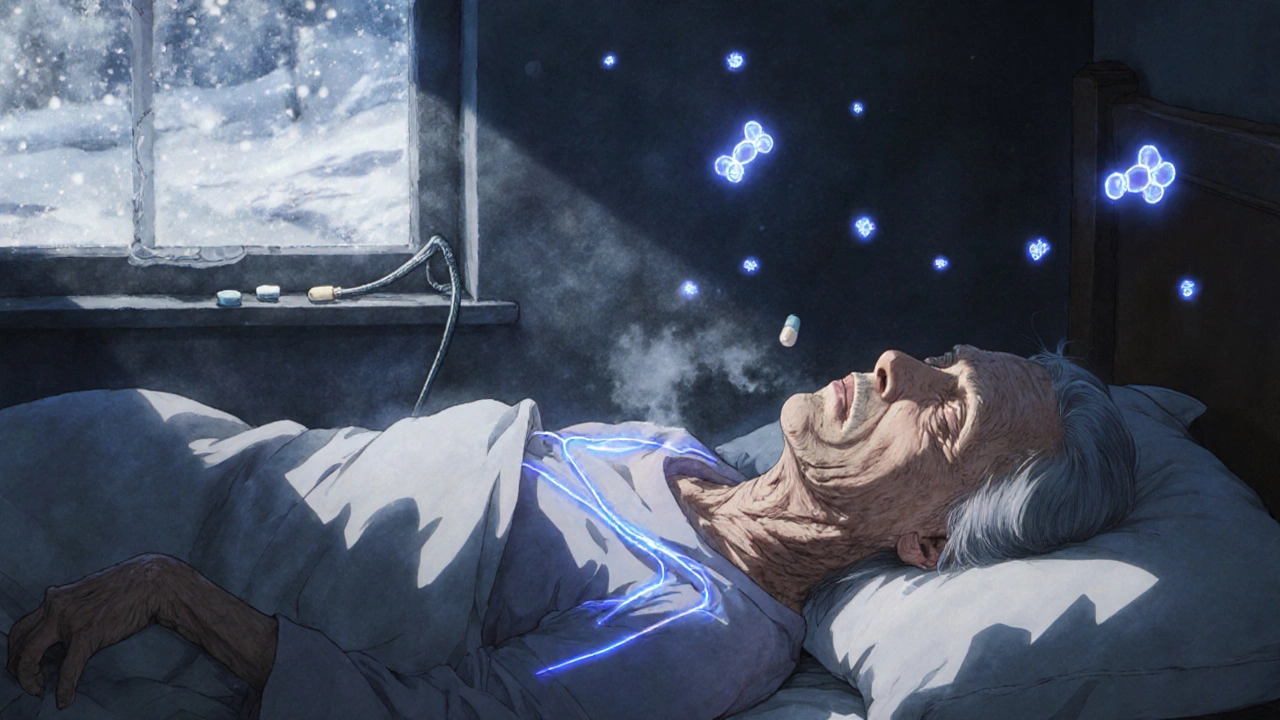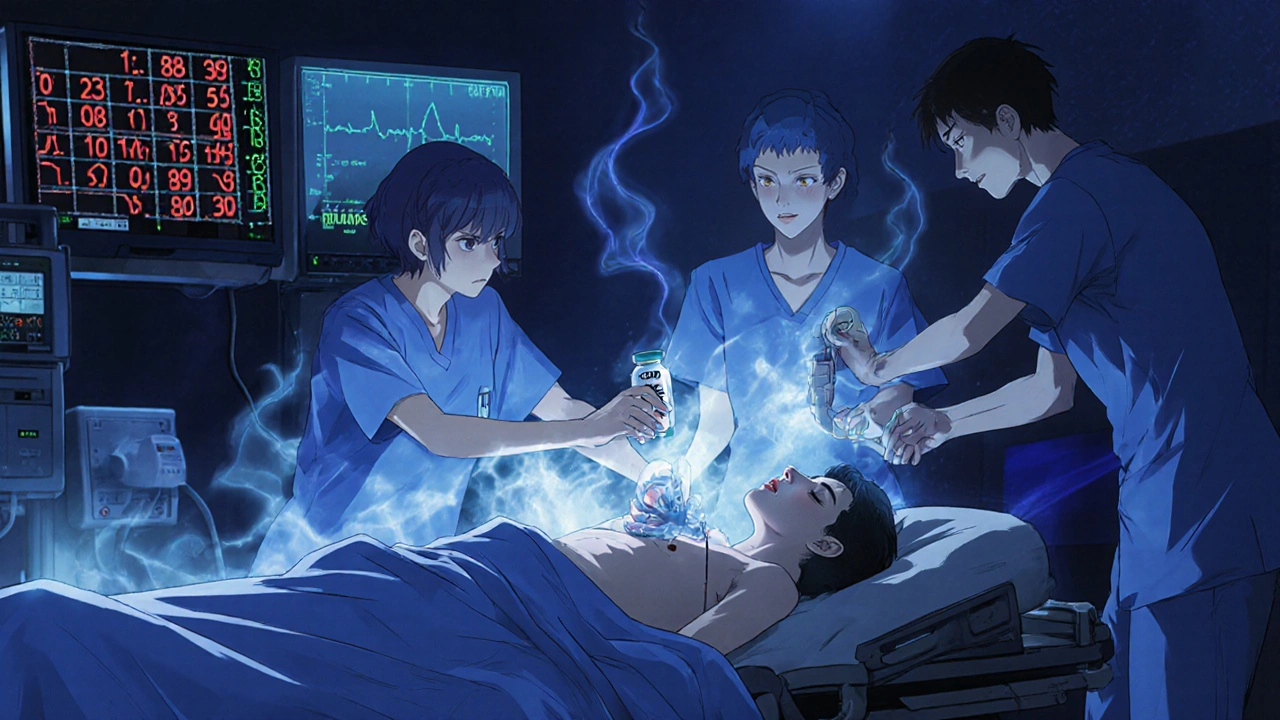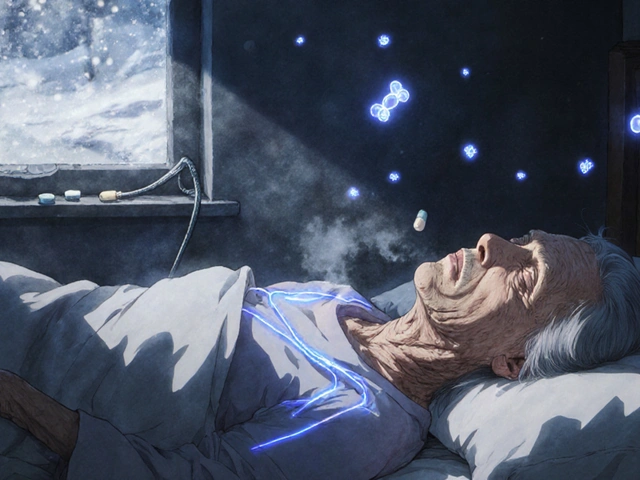
Myxedema coma isn’t just a rare complication of hypothyroidism-it’s a ticking time bomb. Most people with underactive thyroids manage their condition with daily medication and feel fine. But for some, especially older adults, a simple infection, cold snap, or missed dose can trigger a catastrophic collapse. This isn’t a slow decline. It’s a medical emergency that kills 25% to 60% of those who don’t get help fast enough. And the worst part? Many patients are misdiagnosed for months-written off as depressed, senile, or just getting older.
What Really Happens in Myxedema Coma?
Myxedema coma, now more accurately called myxedema crisis, happens when thyroid hormone levels drop so low that your body can’t keep basic functions running. Your metabolism slows to a crawl. Your heart beats too slowly. Your lungs can’t pull in enough oxygen. Your brain starts to shut down. You become lethargic, confused, and eventually unresponsive. Your body temperature plummets below 95°F. You may stop breathing on your own.
This isn’t theoretical. In real cases, patients are found curled up in bed, unresponsive, with puffy faces and swollen legs. Their skin is cold and dry. Their pulse is barely detectable. Their breathing is shallow-sometimes fewer than 10 breaths per minute. Blood tests show sodium levels dangerously low, TSH levels over 100 mIU/L, and free T4 levels near zero. These aren’t lab quirks-they’re signs your organs are failing.
It’s not just about the thyroid. It’s about the cascade. Low thyroid hormones mean your kidneys can’t clear water properly, leading to hyponatremia. Your gut slows down so much you develop ileus-no bowel movements for days. Your liver can’t process drugs or toxins. Your heart struggles to pump, and your blood pressure drops. One system fails, and then another follows.
Who’s at Risk?
Myxedema coma doesn’t strike randomly. It targets people with long-standing, untreated, or poorly managed hypothyroidism. Most are women over 60. The female-to-male ratio is about 3:1, but men often get diagnosed later-sometimes too late. Why? Because their symptoms don’t fit the stereotype. A man with mental fog and cold intolerance might be told he’s just stressed. A woman with depression-like symptoms might be prescribed antidepressants instead of thyroid tests.
Winter is the deadliest season. Cold exposure is a major trigger. A 68-year-old woman in Minnesota skips her levothyroxine for three days during a power outage. She gets a cold. She feels worse. She doesn’t call her doctor. By day five, she’s confused, shivering, and can’t stand up. She’s found by a neighbor. By the time she reaches the ER, her temperature is 89°F. That’s not hypothermia-it’s a warning sign of impending coma.
Other triggers? Infections-especially pneumonia and UTIs-account for nearly half of cases. Hospital stays, especially when medications are interrupted. Strokes or heart attacks. Even stopping thyroid meds after a surgery or during a hospital transfer. A 2022 survey of 427 hypothyroid patients found 18% had a near-miss event. The top reasons? Hospitalizations (47%), infections (32%), and cold exposure (28%).
Why Diagnosis Is So Hard
Myxedema coma mimics everything else. Stroke. Sepsis. Drug overdose. Depression. Dementia. In elderly patients, classic symptoms like weight gain, fatigue, and dry skin are often absent. Instead, they show up with apathetic hypothyroidism-no energy, no interest, no complaints. Just quiet decline. Doctors miss it because they’re looking for fever, high heart rate, or obvious infection. Myxedema coma gives you low temperature, slow heart rate, and no fever. That’s the opposite of what most emergency protocols train for.
One patient in a 2023 case report was treated for depression for 18 months. She was on SSRIs. Her thyroid levels were never checked. Then she got pneumonia. She stopped her thyroid meds. Within a week, she was in a coma. She spent 11 days in the ICU. She survived-but barely.
Even in hospitals, delays happen. Labs take hours. Doctors wait for TSH and free T4 results before acting. That’s deadly. Thyroid hormone replacement must begin within 30 minutes of suspicion-not after lab confirmation. Waiting for results kills.

The Emergency Protocol: What Doctors Must Do
There’s no time for hesitation. The protocol is simple, but it must be done fast and in order.
- Secure the airway. Half to 70% of patients need intubation. Their breathing is too slow. Their cough reflex is gone. They can’t protect their airway. Don’t wait for respiratory failure-intubate early.
- Give IV thyroid hormone immediately. Start with 300-500 mcg of levothyroxine (T4) intravenously. In severe cases, especially with heart problems, add 10-20 mcg of liothyronine (T3) every 8 hours. New guidelines now favor T3 in critical cases-it works faster. Don’t wait for TSH results. Give it now.
- Warm slowly. No heating blankets. No warm IV fluids. Passive rewarming only-cover with blankets, raise room temperature. Aggressive rewarming can cause heart failure. Your body can’t handle the sudden demand for oxygen before your thyroid hormones are restored.
- Treat the trigger. Assume infection until proven otherwise. Give broad-spectrum antibiotics right away. Pneumonia, UTI, sepsis-these are the usual suspects. Don’t wait for cultures. Start antibiotics within the first hour.
- Fix electrolytes carefully. Hyponatremia is common. But correcting sodium too fast can destroy brain cells. Limit correction to 4-6 mmol/L in the first 24 hours. Use fluids cautiously. Monitor sodium every 2-4 hours.
The DIMES mnemonic helps remember triggers: Drugs, Infection, Myocardial infarction/CVA, Exposure to cold, Stroke. Check for all five.
What Happens After Treatment?
When treatment starts early, improvement can be dramatic. Patients wake up within 24 to 48 hours. Heart rate returns. Temperature normalizes. Mental clarity returns. But recovery isn’t guaranteed. Those who wait more than 6 hours have a 10% higher chance of dying for every hour delayed. That’s why speed matters more than perfection.
Long-term, patients need lifelong thyroid hormone replacement. But they also need education. Many don’t know how dangerous missed doses can be. They don’t realize that even a few days without medication can be fatal. Support groups and patient advocacy organizations report that “medical gaslighting” is common-especially for men and younger patients. “I was told I was just anxious,” one 42-year-old man said. “I almost died because no one believed my symptoms were real.”
What’s New in 2025?
Guidelines changed in 2022. The Endocrine Society now recommends liothyronine (T3) as a first-line option in severe cases-not just as backup. A multicenter trial showed a 15% drop in 30-day mortality when T3 was used early. In January 2023, the FDA approved a new IV thyroid hormone formulation called Thyrogen® with faster absorption. It’s not yet widely available, but it’s a step toward quicker treatment.
Research is moving toward early detection. A 2023 Lancet study found that elevated thyrotropin receptor antibodies can predict decompensation before coma hits. Sensitivity: 85%. Specificity: 78%. That’s huge. In the future, point-of-care thyroid tests could give results in 15 minutes-like a rapid strep test. Several devices are in phase 3 trials. Imagine an ER nurse pulling a blood sample and getting TSH and free T4 levels before the patient even reaches the bed.
But the biggest challenge isn’t technology-it’s awareness. The Global Burden of Disease Study predicts a 20% increase in myxedema coma cases by 2030. Why? Aging populations. Undiagnosed hypothyroidism. Limited access to testing in rural and low-income areas. In developing nations, many people with thyroid disease never get tested at all.
What You Can Do
If you or someone you know has hypothyroidism:
- Never skip your medication-even if you feel fine.
- Keep extra pills on hand. Store them where you can reach them during power outages or emergencies.
- Call your doctor immediately if you develop confusion, extreme cold sensitivity, or unexplained lethargy.
- If you’re hospitalized, make sure your thyroid meds are restarted within 24 hours.
- Ask for a thyroid panel if you’re elderly and have unexplained mental changes or low body temperature.
If you’re a caregiver, don’t dismiss slow thinking or cold intolerance as normal aging. It might be the first sign of something deadly.
Can myxedema coma happen to young people?
Yes, but it’s rare. Most cases occur in people over 60, especially women. However, younger patients-including men-are at risk if they have untreated hypothyroidism, stop their medication, or face a major trigger like infection or cold exposure. Younger patients often face longer delays in diagnosis because doctors don’t expect thyroid failure in their 20s or 30s. This leads to higher mortality rates in this group.
Is myxedema coma the same as thyroid storm?
No. They’re opposites. Thyroid storm is caused by too much thyroid hormone-rapid heart rate, high fever, agitation, and high blood pressure. Myxedema coma is caused by too little-slow heart rate, low temperature, confusion, and lethargy. Treatment is completely different. Thyroid storm needs drugs to block hormone production. Myxedema coma needs immediate hormone replacement. Confusing the two can be fatal.
Why can’t you use heating blankets to warm someone with myxedema coma?
Active warming-like heating blankets or warm IV fluids-can cause dangerous shifts in blood flow. When the body warms too fast, blood vessels dilate, but the heart can’t pump enough blood because thyroid hormone levels are still too low. This leads to sudden drops in blood pressure, heart rhythm problems, or even cardiac arrest. Passive rewarming-blankets, warm room, no direct heat-is safer until hormone replacement begins to restore metabolic function.
How long does it take to recover from myxedema coma?
Recovery varies. Most patients show improvement in 24 to 48 hours after starting IV thyroid hormone. Mental status improves first, followed by heart rate and temperature. Full recovery can take weeks. Some patients need weeks of ICU care. Long-term, they’ll need lifelong thyroid replacement, but with proper dosing, they can return to normal life. Delayed treatment increases the risk of permanent brain damage or organ failure.
Can myxedema coma be prevented?
Yes, in most cases. Regular thyroid testing, consistent medication use, and prompt treatment of infections are key. People with hypothyroidism should have TSH checked at least once a year-and more often if they’re elderly or have other health issues. If you’re hospitalized, ensure your thyroid meds are restarted immediately. If you notice worsening fatigue, confusion, or cold intolerance, get your thyroid levels checked right away. Prevention is far easier-and safer-than treating a coma.
Final Thought: Don’t Wait for the Lab
Myxedema coma doesn’t care if your lab results are pending. It doesn’t care if the patient is “too old” for this to be serious. It doesn’t care if you’ve never seen it before. It only cares if you act fast. The difference between life and death isn’t the perfect diagnosis-it’s the first dose of IV thyroid hormone given before the patient stops breathing. If you suspect it, treat it. Now.



this is wild i had an uncle in delhi who stopped his thyroid med for a week after a power cut and just lay there like a statue no one knew why till the neighbor called an ambulance
key point missed in most ed docs: T3 isn't just 'backup' anymore. The 2022 guidelines are clear - in critical myxedema, T3 + T4 IV gives faster hemodynamic stabilization. Waiting for TSH is like waiting for a smoke alarm to confirm the house is on fire.
they don't want you to know this but the FDA approved Thyrogen® because big pharma makes more money off IV hormones than cheap levothyroxine pills. Also cold exposure? That's just a cover for 5G radiation weakening your thyroid. Check the maps.
I mean... I get it. But honestly? This feels like overkill. People just need to take their pills. Why are we turning every missed dose into a Hollywood medical thriller? It's not like it's a new disease.
so basically if you're old and tired you're just gonna die? sounds like the healthcare system just gave up on seniors. also why is everyone always talking about women? men get thyroid stuff too you know.
the passive rewarming thing makes sense i once tried to warm my dog with a hair dryer during a blizzard and he had a panic attack so yeah dont heat fast
this made me cry 😭 my grandma almost died from this and they thought she was just 'being stubborn'... she was 72 and had been on levothyroxine for 15 years... missed one dose after a hospital transfer and... 🤕 thank you for writing this. people need to know.
bro this is gold 🙌 i'm a med student in Punjab and we never learned this in class. my aunt had this and they gave her antibiotics for 3 days before checking TSH. she survived but barely. if you're hypothyroid and feel weird even a little? get tested. no excuses. your life > your pride
Wait, so you're saying people who skip meds are just... irresponsible? And you're blaming the patient? What about the doctors who don't test? What about the 300-dollar co-pay? What about the pharmacy that ran out? You're not fixing the system, you're just shaming people.
i think the biggest issue is that so many people don't realize how fragile their thyroid balance is. i had a friend who stopped her meds because she thought she 'felt fine'... then she got a cold and ended up in the ICU. it's not just about taking pills. it's about understanding that your body is running on a very thin margin.
This article is dangerously alarmist. Myxedema coma is statistically negligible. The real issue is the medical industrial complex profiting off fear. Why not just promote natural thyroid support through selenium and kelp? Why push synthetic hormones?
young people? pfft. if you're under 40 and have hypothyroidism, you're probably just lazy or eating too much gluten. this is a geriatric problem. stop making it a thing.
i wonder if the rise in cases is linked to environmental endocrine disruptors. plastics, pesticides, water fluoridation... we're literally poisoning our thyroid glands without realizing it. the meds are just a bandaid.
interesting piece. reminds me of a case in Glasgow where a man was found unresponsive after a week-long power outage. they didn't know he was hypothyroid until his wife found the empty pill bottle in his coat pocket. tragic but preventable.
we treat the thyroid like it's just a gland. but it's the thermostat of the soul. when it fails, the whole system goes quiet. not just the body. the mind. the will. the spark. we don't see that in labs. we only see numbers. but the silence... that's the real warning.